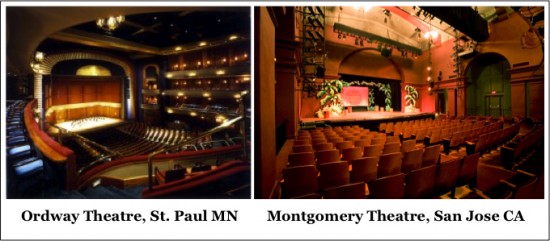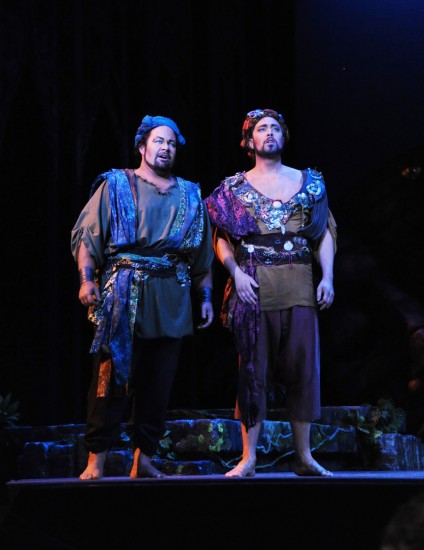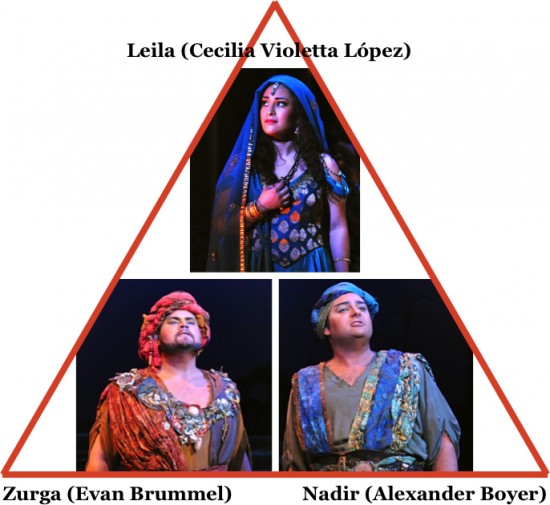I had seen three productions of The Pearl Fishers by the Minnesota Opera (1986, 1991, and 2009), and one by Opera San Jose (2004), so it wasn’t a brand new experience for me. Nor was it brand new for the company who had produced it three times at Montgomery Theatre (1990, 1994, 2004) before the current production at the California Theatre, which I have just seen on September 9, 2012. Still, I feel that I am just beginning to know and appreciate it.
There are three principle characters: baritone Zurga, tenor Nadir, and soprano Leila on a tropical island called Ceylon sometime in the distant past. The two men are each hopelessly in love with Leila; she has eyes only for Nadir. The classic Eternal Triangle – with complications. The two men are bosom buddies and to preserve that friendship they swear not to pursue their love of Leila. To further complicate matters, Leila is a priestess, subject to instant execution if she loses her virginity.
Role Dates
Leila
Nadir
Zurga
Nourabad (Priest)
As usual, Opera San Jose double casts the principle roles as indicated above. I have just seen the opera twice: last week with Cast I and more recently with Cast A. For most of this review I will be talking about the opera itself and this production of it, so I shall refer to people only by their character names. In the picture titles and where I say something about a particular performance, I shall also identify the artist.
The opera opens with an interesting example of a democratic dictatorship. The position of King is vacant and Zurga is elected by acclamation. “OK,” says Zurga, “but this means that my word is law and you all swear to obey me without question.” Everyone so swears and the deed is done.
Nadir returns to the island after an absence devoted to big game hunting and to forgetting Leila.
Nadir and Zurga renew their vow of friendship in a male duet that is generally regarded as one of the finest pieces in all opera. As I write I am listening to a YouTube video of Andrea Bocelli & Bryn Terfel singing it, and shivers are running down my spine. You may think that’s an unfair comparison, but it’s just a reminder of how I felt hearing James Callon and Zachary Altman or Evan Brummel and Alexander Boyer sing it live in the relatively cozy California Theatre. The only piece of music I can possibly compare it with is the duet of Rodrigo and the title character in Verdi’s opera Don Carlos.

Rodrigo (Simon Keelyside) and Carlo (Roberto Alagna) swear eternal friendship; photo still from 2-minute Metropolitan Opera video at http://bcove.me/tdpux4iw
I’d like to carry this comparison a bit further. The two duets are the only memorable tenor-baritone duets that I know of in all opera. The subject is male friendship and loyalty as an intense relationship with absolutely no sexual overtones. They both occur early in the opera, but the unforgettable themes are repeated many times throughout the opera including the dramatic ending or near-ending when one friend willingly sacrifices his life for the other. The two operas have little else in common, but still it makes one wonder a bit. It is apparently a historical fact that Verdi, born a quarter century before Bizet, was greatly admired by the latter and had a strong influence on him. BUT The Pearl Fishers premiered September 30, 1863, and Don Carlos was not staged until March 11, 1867, more than 3 years later. Hmm?
A veiled woman appears – a priestess from a neighboring island, who will pray and stand vigil for the islanders during the upcoming pearl fishing season. Despite her veil, Nadir recognizes her as Leila (are you surprised?), but Zurga and the islanders haven’t a clue. The Triangle ingredients are now all in place and ready to explode.
But first we have a seeming diversion. At the start of Act II the priest Nourabad warns Leila of the consequences if she breaks her vow. “Don’t worry,” she says, “I am brave and will stand by my convictions. Why, when I was a little girl a stranger came to my house fleeing from bandits. I hid him and said nothing, even when the bandits threatened to kill me. When the stranger left he gave me a special necklace of pearls that I always wear in his memory.” – – OK. Back to the Triangle:
In this corner we have Leila whose conflict is between her vow of chastity and her carnal love for Nadir. Leila is a typical opera soprano – vow or no vow, chastity doesn’t stand a chance. Since Nadir is an operatic tenor and fully reciprocates her love, his vow of friendship is also an early casualty. In the third corner, baritone Zurga is a more complex character. He is King and has a moral duty to enforce the laws of the village; he feels closely bound to Nadir; he is in love with Leila and is intensely jealous when he suspects Nadir of gaining her affections.
When the illicit affair is discovered, the law demands that both of the guilty parties be burned to death. As King, Zurga should enforce that law, but as an absolute monarch he grants them a royal pardon – his friendship vow with Nadir demands no less. However, when he finds out the identity of the veiled priestess, he is overcome by jealous rage and shouts, “burn them both at sunrise.” But after a restless night his better nature prevails and he decides to free them. And so it goes. Every time he thinks about it or gets more information, he changes his mind! And if you want to know the final result you’ll have to come to one of the two remaining performances: Friday September 21 at 8:00 or Sunday September 23 at 3:00.
Despite the fact that the soloists did relatively little cavorting about the stage, my overall impression of the opera as a whole is one of vibrant energy. This is largely due to the well-managed chorus and the dance ensemble. They got the opera off to a rousing start, and never let up. Their contribution to the finale to Act I was one of the musical highlights of the opera, and both their singing and their actions contributed to the tension in the final scene – the one I’m not telling you about. The choreography and blocking were perfect. For example, shortly before the finale the chorus is all on stage when suddenly they receive news that their village is on fire. Everyone immediately heads for home in what appears to be chaos, but with nary a collision to delay their speedy departure.
The chorus was complemented by a septet of dancers from Ballet San Jose School and Lise la Cour’s LaCademy led by 13-year-old Daniel McCormick. Readers who attended last year’s performance of Idomeneo may recall seeing a young boy dancer dressed up as King Neptune. Well, that boy was 12-year-old Daniel! According to General Manager Larry Hancock, he grew 18 inches in the intervening year. That young man is a dancer worth watching.
2149 Paragon Drive
San Jose CA 95131-1312
408-437-4450
345 South First Street
Betw. San Carlos & San Salvador
Downtown San Jose
Photos (except as indicated) by Pat Kirk
This review by Philip G Hodge appeared in sanfranciscosplash.com on September 17, 2012.









